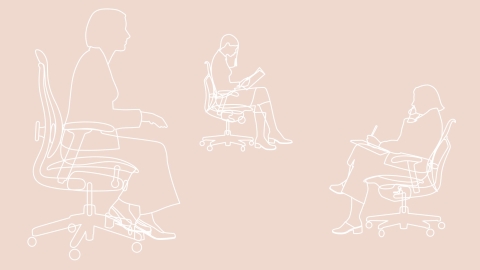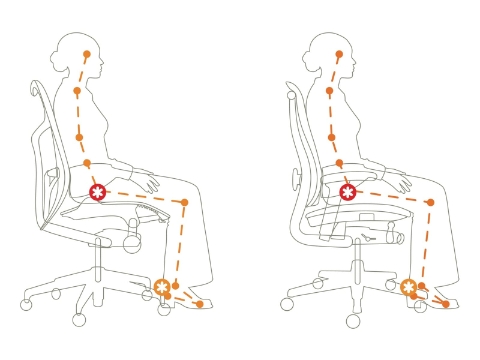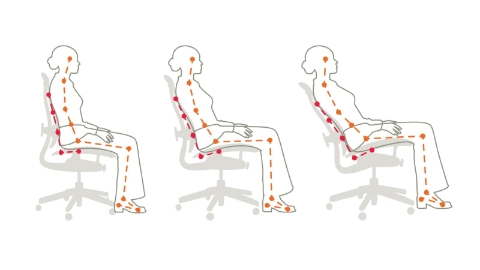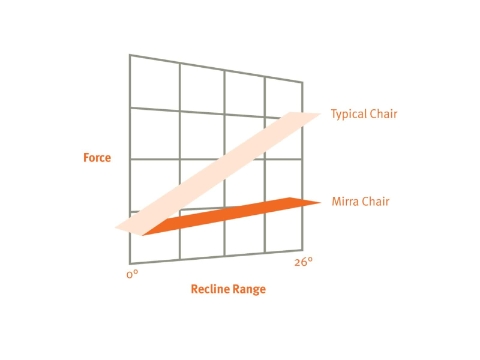Supporting the Biomechanics of Movement
The Science and Research Behind the Harmonic Tilt
Download PDF (275 KB)
A work chair’s movement should mirror the movements of the sitter. Kinematics make this possible; they are to a chair what suspension is to a car. A work chair can offer a great seat and backrest design, but without great kinematics, the work chair will not move with and respond to the sitter’s movements and postures.
What We Know
The seated body has natural pivot points at the hip, knee, and ankle. The ideal work chair will mimic as closely as possible those pivot points, thus allowing the sitter to move naturally and with ease around the chair’s engineered pivot points. The pivot points within the sitter’s body and the movement of the chair should work together to create a tilt movement that doesn’t stress or lift the body.
The type and engineering of a work chair’s tilt will make the difference between dynamic and static seating.
A chair with a center tilt pivots around a point under the center of the chair’s seat. In this simple design, the chair’s backrest and seat usually move together in a 1:1 ratio. This means the sitter’s feet will come off the floor when leaning back, and it will be difficult to hold a reclined position in any relaxed fashion. Because the sitter’s feet come off the floor, a chair with a center tilt will give the sitter a feeling of instability.
A chair with a knee tilt pivots the chair’s seat around a point under the seat and behind the sitter’s knees. The sitter’s feet will stay on the floor, which lends greater stability and provides user control over the recline action of the chair. A chair with a knee tilt pivots the seat and backrest, though not necessarily at the same rate. Because the seat-to-backrest ratio is still fairly even, the sitter’s body angles will not comfortably open and relax when reclining, increasing the chances for muscle fatigue and restricted circulation.
A chair with an ankle tilt pivots the seat around a point located near the sitter’s ankle, which is the center of the seat’s fulcrum. Like a knee tilt, the sitter’s feet remain on the floor. But with an ankle tilt, the sitter also has constant and efficient control over the recline action of the chair.
A chair with a hip pivot rotates the backrest around a point located near the sitter’s hips. This point, which is between the chair’s seat and backrest, helps the sitter to maintain full contact with the chair’s seat and backrest through the full range of recline. The chair’s pivot closely mimics the body’s hip when the sitter tilts back in the chair.
A synchronous tilt establishes a prearranged relationship between the movement of the chair’s seat and backrest. This relationship allows the body to open up as the sitter reclines. A work chair that has a synchronous tilt and can closely approximate the ankle and hip pivot points of the body will provide the most comfortable and relaxed experience for the sitter.
Further, a tilt should produce a characteristic that we call dwell. Dwell provides the user the ability to maintain balance at any position within the recline range of a chair. A chair has to have an energy source to counteract shifting weight when the sitter moves her body’s center of gravity. This is especially true if the movement is to mimic the body’s natural pivot points. If a chair merely balances shifting weight, its motion is foreign to the natural motions of the body.
Therefore
The more closely a work chair moves like the body, the more likely it is that the sitter will move his or her body while seated in it.
The ideal work chair will mimic the body’s natural pivot points and allow the sitter to move naturally around the chair’s engineered pivot points. A work chair needs a synchronous tilt to allow the sitter’s body to open up as it reclines.
And because gross torso postures change approximately 53 times an hour, or about once every minute, the ideal work chair must allow the user’s body to remain relaxed as postures are changed and maintained (Dowell et al., 2001).
Design Problem
Kinematics are to a chair what suspension is to a car. A work chair can offer a great seat and backrest design, but without great kinematics, the work chair will not support the sitter’s movements and postures.
When sitters move through the tilt range of a typical work chair, they might be supported at the beginning and at the end, but not equally through the entire “ride” of the chair. Sitters need to have the same level of support throughout the travel range. They need to feel balanced and supported while moving anywhere within the recline range.
Design Solution
Celle and Mirra 2’s tilt motions build upon the kinematic research that previously helped develop the Aeron chair and the original Harmonic Tilt. Designed to echo, or mirror, the natural pivot points of the human body, the designers were able to optimize the motion of these tilts by locating the pivot points extremely close to the natural pivot points of the human body. / See Figure 1 /
The Harmonic Tilt originated with the Mirra chair. During development of that chair, its designers took advantage of a new measurement tool to evaluate and refine the motion or “ride” of the chair. Mechanical prototypes of the design were analyzed using a system that recorded the position of reflective markers located at strategic points on the chair and on the test subject sitting in the chair. The system tracked the motion of these markers as the subject moved from an upright to a reclining posture and back again (Danek et al., 1999). / See Figure 2 /
Later, the Harmonic Tilt was evolved into a platform, allowing the design and engineering of the tilt to be incorporated into other Herman Miller work chairs, including the Celle chair. The Harmonic Tilt 2 tilt further extends the performance and comfort of the unique Harmonic Tilt while making the Mirra 2 chair visually leaner and physically lighter.
When a sitter tilts back in a Mirra 2 or Celle chair, the body revolves around the pelvis/hip joint. In both designs, the chair’s hip pivot closely approximates that of the sitter’s natural hip pivot and the tilt motion transfers the sitter’s weight from the seat to the backrest without changing the relationship between the backrest and the sitter’s back. This mirroring reduces the possibility of shearing, in which the backrest and/or seat moves away from the sitter’s body during recline. Further, the chairs’ ankle pivots are located at approximately the height of the sitter’s ankle joint, so that there is no lifting of the heels when the sitter is in a reclined position. These synchronous tilts allow the sitter, in a sense, to forget the chair is there. Celle’s backrest-to-seat ratio during recline is a comfortable 2.2:1, Mirra 2’s begins at a similar 2.1:1 and moves to 2.4:1 in deeper recline.
As a chair reclines, the rate of the tilt’s spring provides resistance to the user’s force. Typically, any tilt energy source has a single “ride-curve,” which moves through the same spring rate regardless of the changing force on the spring (adjusting tilt tension merely rearranges the pre-load to the same spring constant). In such tilts, where the force-to-resistance ratio is linear, the amount of force it takes for the sitter to recline the first five degrees in the range is less than the force it takes for the same sitter to recline the last five degrees. In other words, the resistance to the sitter’s movement is not even. Heavier people slip from full upright positions into reclined positions to balance, and lighter people struggle to get a chair to fully recline.
Alternatively, the Harmonic Tilts, referred to as virtual variable rate springs, introduce the notion of a moving fulcrum in their mechanisms. Designed to react in a nonlinear way, meaning that the sitter will feel the same amount of resistance anywhere within the range of recline, they balance the spring tension and ride to the weight of the user. In other words, the sitter experiences the same balanced ride regardless of recline position. / See Figure 3 /
The balanced ride of the original Harmonic Tilt was developed using the concepts of fully automatic tilt-balancing and applying them to a simpler tilt. The Harmonic Tilt and Harmonic Tilt 2 tilt are like automatic-focus cameras, where the user slightly depresses a button and the camera adjusts to the image. The Harmonic Tilt mechanisms utilize a unique composite leaf spring as the energy source, and by moving the fulcrum in a synchronized fashion through the recline range, the spring rate begins to shift. As a result, a person weighing up to 350 pounds (158 kilograms) sitting in a Celle or Mirra 2 chair can enjoy a balanced ride through the full recline range. Additionally, Mirra 2 does an unusually good job of balancing lighter users of around 100 pounds (45 kilograms).
The tilt designs of the Mirra 2 and Celle chairs change the center of gravity as the sitter moves and reclines. Once the sitter tunes the tilt tension to his or her weight, the chair takes over. The ability of the Harmonic Tilts to adjust this way indeed provide a better experience for heavier users, who have come to expect a chair that reclines too quickly and without control, and for lighter users, who have come to expect a work chair that can’t recline without exerting an uncomfortable and often impossible amount of energy.
The Harmonic Tilts respond to their sitter’s size and provide balanced support as the sitter moves from an upright posture to a completely reclined one and anywhere within that recline range. The Harmonic Tilt designs also significantly improve the dwell, so the chairs offer far more controlled and relaxed movement than most work chairs.
The primary goal throughout the development of any Herman Miller work chair is to design a chair with natural performance—natural meaning intuitive and supporting the body without demanding much effort or thought from the sitter. That goal has been realized in both the Celle and Mirra 2 chairs through the Harmonic Tilt and Harmonic Tilt 2, respectively, which provide a natural motion for the body, both as it reclines and as it stops anywhere within the recline range.
References
Danek, Thelen, and Veldman (1999), “Chair Tilt Analysis: Comparison Study,” Hope College Department of Physics and Engineering.
Dowell, Green, and Yuan (2001), “Office Seating Behaviors: An Investigation of Posture, Task, and Job Type,” Proceedings of the Human Factors and Ergonomics Society 45th Annual Meeting.
Credits
Jerome Caruso is the designer of Celle chair. Caruso’s designs extend beyond seating and the workplace. As Sub-Zero’s designer for over 20 years, Caruso has been influential in shaping the look and function of kitchen products and appliances. The innovative mind and design expertise of Caruso is evident in the more than 75 design patents he holds. Jerome and his son, Steven, designed Herman Miller’s Reaction chair in 1998.
Bill Dowell was Herman Miller’s board-certified Corporate Ergonomist at the time of his death in 2012. During his 28-year career at Herman Miller, Bill was instrumental in leading research into the study of ergonomics and applying the principles of good ergonomic design to our products. In 1991, Bill played a pivotal role in Herman Miller becoming a charter member of the Office Ergonomic Research Committee (OERC). Bill was a key member of the BIFMA Ergonomics Subcommittee that was responsible for the original BIFMA Ergonomic Guideline for VDT Furniture, and was also a member of the committee that revised the BSR/HFES 100 Standard for Human Factors Engineering of Computer Workstations. He was also a member of the CAESAR 3-D surface anthropometric survey and the Human Factors and Ergonomics Society, representing Herman Miller in both groups. Bill’s published work includes studies of seating behaviors, seated anthropometry, the effect of computing on seated posture, the components of subjective comfort, and methods for pressure mapping.
Championing research and creativity in the earliest phases of Herman Miller’s product development efforts, Gretchen Gscheidle leads the team that explores unmet customer needs and responds to strategic questions identified by various organizational leaders. As the research link in all of the company’s seating introductions beginning with the Aeron chair in 1994, Gretchen has a strong record of participation and contribution in product development at Herman Miller. She is a member of the Human Factors and Ergonomics Society and represents Herman Miller on the Office Ergonomics Research Committee. Her research has been published in peer-reviewed journals. Gretchen earned a BFA in Industrial Design from the University of Illinois at Urbana-Champaign and graduated from Northwestern University’s McCormick School of Engineering with a Master’s of Science in Product Design and Development.
Studio 7.5, located in Berlin, Germany, designed the Mirra chair, the Setu chair, and, most recently, Mirra 2—a complete redesign of the original. Designers Burkhard Schmitz, Claudia Plikat, Carola Zwick, and engineer Roland Zwick lead the design firm, which opened in 1992. Also active in education, the designers teach industrial design and product design at universities in Germany. An interest in the tools that define how people work has led Studio 7.5 to design software interfaces, office seating, and medical equipment. Studio 7.5 has been collaborating with Herman Miller for over 20 years.



